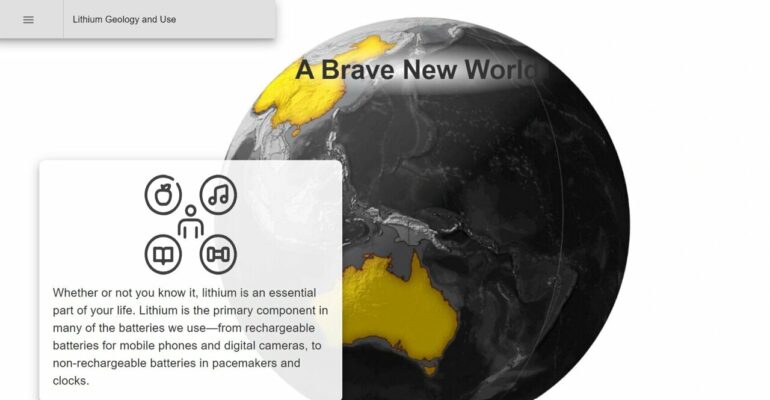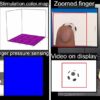As product managers at the National Renewable Energy Laboratory (NREL), Nicholas Gilroy and Haiku Sky help turn complex information into a compelling journey on the web. Their work allows users to interact with data and even download information as the story of research unfolds.
Working closely with user experience researchers and engineers, the two helped the U.S. Department of Energy’s Geothermal Technologies Office (GTO) develop a new Lithium Story Map for energy.gov that lays out the relationship between geothermal energy and lithium via images, animation, maps, and narrative.
Since its launch on Aug. 24, 2022, the Lithium Story Map has more than 1,600 views. The concept is a first-of-its-kind project for the Department of Energy website, bringing science to the masses in a way that feels closer to scrolling through social media for knowledge rather than hunkering down with a textbook.
The Lithium Story Map allows visitors to scroll through the role of lithium in renewable energy today, see how the critical material is currently obtained, and understand why the Salton Sea region of California may prove a key domestic source—with a little help from geothermal energy.It also explains why GTO investment in technologies supporting lithium extraction from geothermal brines is so important to a green economy.
“It is possible that domestic lithium extraction from geothermal brines could secure a long-term source of this critical material, create clean energy jobs, and lower the costs of lithium use for key products like rechargeable batteries,” said Elisabet Metcalfe, GTO stakeholder engagement lead.
We talked with developers Sky and Gilroy right before launch about their process, how story maps could change the game, and what they learned.
Story mapping
The term “story map” originated as part of the ArcGIS mapping software several years ago, but maps and data have told stories for centuries—the stories were often just harder to decipher.
GTO approached Sky and Gilroy with the story map concept in relation to lithium because the form can disseminate high-impact takeaways for multiple audiences.
“For the Lithium Story Map in particular, it was important to have a strong narrative to begin with and a clear entry point,” Gilroy said. “The goal was to set context—lithium is something that is all around us in our modern world. If someone can relate, then we have a hook and can go to the next level of information, describing Lithium’s life cycle, where it comes from, how it’s produced, and how we might find new sources to meet the growing demand.”
He said the use of a story map enables NREL to convey why specific research areas or initiatives are important and should be prioritized.
“This new data visualization is a big departure from the typical way technical information is shared,” Sky said. “We built something custom that is really—we hope—beautiful and interesting to look at.”
John Oliver + NREL?
The duo found inspiration to bring the GTO story map vision alive through an unlikely source—a TV talk show. “Last Week Tonight with John Oliver” created a video about the electricity grid, which went on to earn almost 6 million views.
Gilroy said the entire video is referencing an NREL report.
“This is what NREL does all the time, talking about the transition to clean energy. How is he getting traction?” he said. “Why are people responding to it? Because he’s meeting people where they are at. People are used to consuming something on TV, YouTube, or HBO. You have to make it accessible and understood on a mobile device or social platform.”
Sky said the Lithium Story Map offers a similar voice.
“As a user scrolls, you get to see the data over time and tie it to key important things that occurred throughout history that are relevant to lithium,” he said. “It’s a very passive and effective way for a person to consume information.”
What is next for story maps and geothermal?
Gilroy said more story maps are in the works for the team, as they continue to develop the platform.
“We are continuously thinking through the user experience—what are the needs, attitudes, emotions, and behaviors of people who use our products,” he said, “and how can we meet them where they like to be to allow them to consume information in ways they are used to.”
“One of the things I love about working at NREL,” Sky said, “is when there are dual or multipurpose ways to solve problems—like agrivoltaics or solar siding. Geothermal energy generation plus lithium extraction could be a game changer.”
Leveraging geothermal plants for the direct extraction of lithium avoids having to create new, and expensive, specialized infrastructure. By using tools that already exist, the industry can help solve scientific hurdles and advance toward a more renewable future.
How many of your devices need lithium?
How many items in your home or workplace use lithium? And not just use it, but could not exist without it?
Lithium is an essential ingredient in our day-to-day lives, as well as the future of renewable energy. It is the primary component in rechargeable batteries for mobile phones and digital cameras, electric vehicle batteries and solar panels, and even the non-rechargeable batteries found in life-saving pacemakers.
As lithium demand continues to grow, extraction from geothermal fluids is of growing interest. The underground brine contains this scarce element, meaning geothermal energy may soon play a greater role in our lives and in the green economy.
Provided by
National Renewable Energy Laboratory
Citation:
The relationship between geothermal energy and lithium (2022, September 27)



